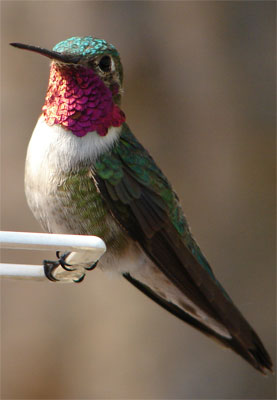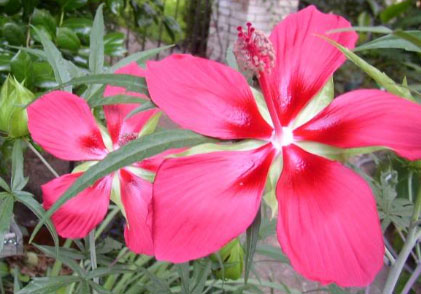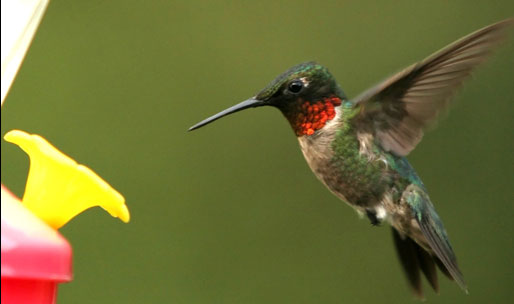Weekend Gardening: It’s Easy To Attract Hummingbirds
September 13, 2014
by Santa Rosa County Extension
Few sights are more thrilling in the garden than rapidly moving hummingbirds darting among colorful flowers. Hummingbirds, also known as hummers, are always a wonder to see, and it’s easy to attract them to your garden.
In Florida, we see three different types of hummingbirds, but the most common is the ruby-throated. This feathered jewel is only about three inches long and weighs as little as a single penny.
For their size, hummingbirds have among the largest appetites in the bird world. They feed every 10 or 15 minutes from dawn until dusk. During this period, they eat more than half their weight in food and 8 times their weight in water.
If you’re fascinated by hummingbirds, you probably hang out a feeder or two in the summer to provide them with sugar water. Artificial feeders will attract hummingbirds.
 However, feeders should not be the sole source of food provided. The sugar solution may appeal to the hummingbirds’ sweet tooth, but it provides little nourishment. Nectar is much more vital to the hummingbird than just water and sugar. By planting certain flowers and shrubs, home gardeners can provide food and habitat for hummingbirds.
However, feeders should not be the sole source of food provided. The sugar solution may appeal to the hummingbirds’ sweet tooth, but it provides little nourishment. Nectar is much more vital to the hummingbird than just water and sugar. By planting certain flowers and shrubs, home gardeners can provide food and habitat for hummingbirds.
Typical hummingbird flowers are red, have a tubular shape and have no strong scent. But there are several notable exceptions to this general rule. Many plants with red flowers don’t contain very much nectar. Roses, petunias, geraniums and zinnias have brilliant colors but little nectar.
Plants that produce an abundance of flowers over an extended period of time and those that require little care are good choices. Native plants can “fill the bill” where nectar-seekers are concerned and should be used whenever possible.
 Perennials that are recommended as nectar sources include butterfly milkweed (Asclepias tuberosa), red basil (Calamintha coccinea), shrimp plant (Justicia brandegeana), cigar plant (Cuphea ignea), firespike (Odontonema stricta), red star hibiscus (Hibiscus coccineus), and obedient plant (Physostegia spp.).
Perennials that are recommended as nectar sources include butterfly milkweed (Asclepias tuberosa), red basil (Calamintha coccinea), shrimp plant (Justicia brandegeana), cigar plant (Cuphea ignea), firespike (Odontonema stricta), red star hibiscus (Hibiscus coccineus), and obedient plant (Physostegia spp.).
It’s also important to plant a mixture of nectar producing trees, vines and shrubs that have overlapping blooming seasons. This will insure that a continuous source of nectar will be available to hummingbirds throughout the growing season. Some of the species recommended include red buckeye, bottlebrush, firebush (Hamelia patens), wild azalea, trumpet vine, and coral honeysuckle.
Contrary to popular belief, hummingbirds are not strictly nectar feeders. Insects and other invertebrates are the primary source of protein for adult hummingbirds and their young. An adult female can consume up to 2,000 insects per day. Small invertebrates including mosquitoes, gnats, small bees, fruit flies, spiders, caterpillars, aphids, and insects eggs make up the hummingbirds diet. So keep your plants free of pesticides. Pesticides destroy the insect food base vital to hummingbirds and their offspring, and may also contaminate the nectar they drink.
 And if you do use artificial feeders, remember that the sugar solutions must be kept fresh. Florida’s hot weather can cause rapid bacterial growth in these feeders and birds that drink contaminated water could die. To avoid this, change the solution every 3 to 5 days. Clean the feeders with hot water and white vinegar. Do not use soap or chlorine bleach.
And if you do use artificial feeders, remember that the sugar solutions must be kept fresh. Florida’s hot weather can cause rapid bacterial growth in these feeders and birds that drink contaminated water could die. To avoid this, change the solution every 3 to 5 days. Clean the feeders with hot water and white vinegar. Do not use soap or chlorine bleach.
Comments
2 Responses to “Weekend Gardening: It’s Easy To Attract Hummingbirds”



I live in Warrington and would like to attract hummers to my garden. I haven’t noticed to many yet this year. Is there a certain time of the year that they arrive? I wrote down the flowers and bushes that attract them.
It’s a shame thay done eat love bugs